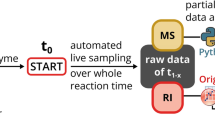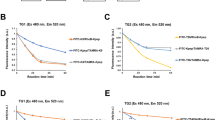Abstract
A new method to determine the catalytic parameters of l-asparaginase using circular dichroism spectroscopy (CD spectroscopy) has been developed. The assay is based on the difference in CD signal between the substrate (l-asparagine) and the product (l-aspartic acid) of enzymatic reaction. CD spectroscopy, being a direct method, enables continuous measurement, and thus differentiates from multistage and laborious approach based on Nessler’s method, and overcomes limitations of conjugated enzymatic reaction methods. In this work, we show robust measurements of l-asparaginase activity in conjugates with PEG–chitosan copolymers, which otherwise would not have been possible. The main limitation associated with the CD method is that the analysis should be performed at substrate saturation conditions (V max regime). For K M measurement, the conductometry method is suggested, which can serve as a complimentary method to CD spectroscopy. The activity assay based on CD spectroscopy and conductometry was successfully implicated to examine the catalytic parameters of l-asparaginase conjugates with chitosan and its derivatives, and for optimization of the molecular architecture and composition of such conjugates for improving biocatalytic properties of the enzyme in the physiological conditions. The approach developed is potentially applicable to other enzymatic reactions where the spectroscopic properties of substrate and product do not enable direct measurement with absorption or fluorescence spectroscopy. This may include a number of amino acid or glycoside-transforming enzymes.

“Reagent-free” l-asparaginase activity assay based on CD spectroscopy and conductometry




Similar content being viewed by others
References
Ravindranath Y, Abella E, Krischer JP et al (1992) Acute myeloid leukemia (AML) in Down’s syndrome is highly responsive to chemotherapy: experience on pediatric oncology group AML study 8498. Blood 80:2210–2214
Pui CH, Evans WE (2006) Treatment of acute lymphoblastic leukemia. N Engl J Med 354:166–178
Redaelli A, Laskin BL, Stephens JM et al (2005) A systematic literature review of the clinical and epidemiological burden of acute lymphoblastic leukaemia (ALL). Eur J Cancer Care 14:53–62
Billett AL, Carls A, Gelber RD, Sallan SE (1992) Allergic reactions to Erwinia asparaginase in children with acute lymphoblastic leukemia who had previous allergic reactions to Escherichia coli asparaginase. Cancer 70:201–206
Uren JR, Ragin RC (1979) Improvement in the therapeutic, immunological, and clearance properties of Escherichia coil and Erwinla carotovora l-asparaginases by attachment of poly-DL-alanylpeptides. Cancer Res 39:1927–1934
Papageorgiou AC, Posypanova GA, Andersson CS et al (2008) Structural and functional insights into Erwinia carotovora L-asparaginase. FEBS J 275:4306–4316
Kuchumova A, Krasotkina IV, Khasigov PZ, Sokolov NN (2007) Modification of recombinant asparaginase from Erwinia carotovora with polyethylene glycol 5000. Biomed Khim 53:107–111
Mozhaev VV, Kudryashova EV, Efremova NV, Topchieva IN (1996) Stability of chymotrypsin conjugated with poly(ethylene glycols) and proxanols at high temperature and in water-cosolvent mixtures. Biotechnol Tech 10:849–854
Soares AL, Guimara GM, Polakiewicz B et al (2002) Effects of polyethylene glycol attachment on physicochemical and biological stability of E. coli L-asparaginase. Int J Pharm 237:163–170
Dinndorf PA, Gootenberg J, Cohen MH et al (2007) FDA drug approval summary: pegaspargase (oncaspar) for the first-line treatment of children with acute lymphoblastic leukemia (ALL). Onkologist 12:991–998
Kudryashova EV, Zorov IN, Vasilyeva IV et al (2009) Stabilization of alkaline proteinase and cellulases by complex formation with chitosan. Bioorg Khim 35:1–8
Lin WJ, Chen MH (2007) Synthesis of multifunctional chitosan with galactose as a targeting ligand for glycoprotein receptor. Carbohydr Polym 67:474–480
Wade HE, Phillips BP (1971) Automated determination of bacterial asparaginase and glutaminase. Anal Biochem 44:189–199
Wriston JC, Yelln TO (1973) L-asparaginase: a review. Adv Enzymol Relat Areas Mol Biol 39:185–248
Kotzia GA, Lappa K, Labrou NE (2007) Tailoring structure-function properties of L-asparaginase: engineering resistance to trypsin cleavage. Biochem J 404:337–343
Omelianuk NM, Borisova АA, Aleksandrova SS et al (2005) Optimizing of expression of Erwinia carotovora recombinant L-asparaginase. Biotekhnolgiya 3:27–34
Sukhoverkov KV, Kudryashova EV (2015) PEG chitosan and glycol chitosan for improvement of biopharmaceutical properties of recombinant L asparaginase from Erwinia carotovora. Biochemistry 80:113–119
Kudryashova EV, Sukhoverkov KV, Sokolov NN (2014) Application of PEG-chitosan copolymers for regulation of catalytic properties of enzymes for medical application using recombinant Erwinia carotovora l-asparaginase as an example. Biochem Suppl Ser B Biomed Chem 8:252–259
Drainas D, Drainas C (1985) A conductimetric method for assaying asparaginase activity in Aspergillus nidulans. Eur J Biochem 593:591–593
Kudryashova EV, Gladilin AK, Vakurov AV et al (1997) Enzyme-polyelectrolyte complexes in water-ethanol mixtures: negatively charged groups artificially introduced into alpha-chymotrypsin provide additional activation and stabilization effects. Biotechnol Bioeng 55:267–277
Acknowledgments
This project was supported by RFBR grants 14-04-00325A, and using equipment purchased in the frames of development programs of Lomonosov MSU 2011–2015.
Author information
Authors and Affiliations
Corresponding author
Ethics declarations
Conflict of interest
The authors declare that they have no competing interests.
Rights and permissions
About this article
Cite this article
Kudryashova, E.V., Sukhoverkov, K.V. “Reagent-free” l-asparaginase activity assay based on CD spectroscopy and conductometry. Anal Bioanal Chem 408, 1183–1189 (2016). https://doi.org/10.1007/s00216-015-9222-0
Received:
Revised:
Accepted:
Published:
Issue Date:
DOI: https://doi.org/10.1007/s00216-015-9222-0




